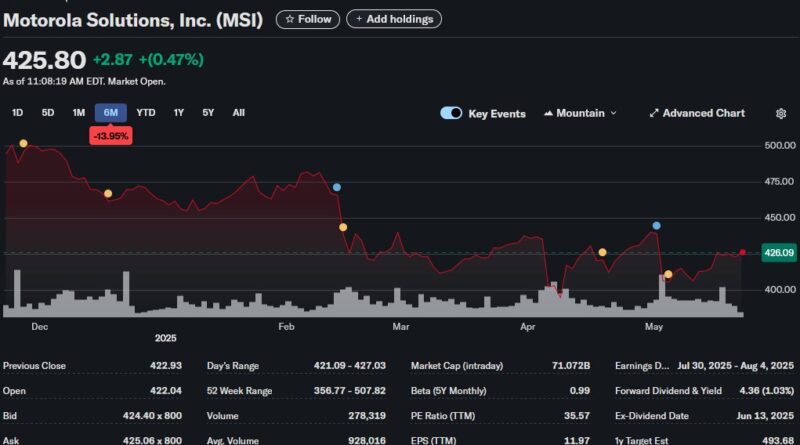Motorola’s Potential $4.5B Silvus Buyout – Opportunity or Risky Bet?
Buckle up, investors! Motorola Solutions (MSI) is reportedly in advanced talks to acquire Silvus Technologies, a wireless-radio manufacturer, for a hefty $4.5 billion. This deal has sparked buzz, but is it a game-changer for Motorola or a risky bet? Let’s break it down, Fearless Investor style, and think through the opportunities, risks, and strategies.
The Deal: Why It Sounds Good
Silvus Technologies specializes in advanced wireless communication systems, particularly for defense and public safety—think military-grade radios and secure networks for first responders. With geopolitical tensions driving demand for such tech, Silvus’s customer base (think government contracts, defense agencies) could bolster Motorola’s already strong position in the communication equipment space. Motorola’s existing portfolio, including its land mobile radio networks used by emergency services globally (like the $330M contract with Victoria, Australia), aligns perfectly with Silvus’s offerings. This synergy could expand Motorola’s market share and diversify revenue streams, especially in high-margin, recession-resistant sectors like public safety and defense.
Analysts are bullish, with a 12-month price target of $495.44, implying a 17.15% upside from the current $422.93 stock price. Motorola’s recent performance supports this optimism: Q1 2025 earnings beat estimates, with a 17% year-over-year increase in operating cash flow to $2.4B and a 15-year streak of dividend payments (11.22% growth over the last year). The Silvus deal could amplify this growth by adding cutting-edge tech and contracts, potentially strengthening Motorola’s competitive moat.
The Catch: Merger Math and Market Realities
Mergers, even promising ones, often come with growing pains. Historical data shows that acquisitions can flatline or reduce earnings for 12-18 months due to integration costs, debt, or operational hiccups. Motorola’s $4.5B price tag for Silvus, while not astronomical for a company with a $70.57B market cap, could strain margins if integration falters. The deal’s size suggests Motorola might tap its $2.25B credit facility or issue new debt, potentially increasing its debt-to-equity ratio (currently 3.30).
Moreover, Motorola’s stock dipped 7.7% after its Q4 2024 earnings despite beating EPS expectations, suggesting investor skepticism about short-term headwinds like tariffs or currency challenges. A pricey acquisition could amplify this volatility, especially if Silvus’s revenue contributions take time to materialize. If the market perceives the deal as overvalued (Motorola’s P/E is already high at 45.85), a pullback could follow.
Is This a Buy Opportunity?
The potential for a post-merger dip makes Motorola intriguing for fearless investors. If the stock pulls back due to short-term earnings pressure or integration costs, it could create a buying opportunity, especially if the long-term synergies with Silvus pan out. Analysts’ $495.44 target assumes organic growth, acquisitions, and buybacks will drive EPS higher (forecasted at $13.55 for 2025, up from $12.33 pre-earnings). A dip below $400 could bring the stock closer to its 52-week low ($360s), offering a better entry point for long-term holders.
However, timing is key. Mergers often trigger volatility, and Motorola’s high P/E suggests limited room for error. If the deal closes and integration issues emerge, the stock could lag for 6-12 months, aligning with the typical 18-month merger drag.
Puts, Shorts, or Covered Calls?
- Puts and Shorts: For bearish investors, puts or shorts could capitalize on a potential post-merger dip, especially if earnings disappoint or integration costs balloon. However, Motorola’s strong fundamentals (84.17% institutional ownership, consistent dividends) and analyst optimism make shorting risky. Puts with a 3-6 month horizon, targeting a 5-10% drop, might be safer for hedging or speculating, but beware of the stock’s resilience.
- Covered Calls: For those holding MSI long, covered calls are a smart play. With a 17.15% upside projected, selling out-of-the-money calls (e.g., $450 or $475 strikes) could generate premium income while capturing potential gains. If the stock flatlines post-merger, the premiums cushion your position; if it rallies, you still profit up to the strike price. This strategy suits investors bullish on Motorola’s long-term prospects but cautious about near-term volatility.
- Long Position: Holding or buying on a dip aligns with Motorola’s strong fundamentals and the deal’s strategic fit. The defense and public safety sectors are relatively insulated from economic downturns, and Silvus’s tech could drive multi-year growth. Patience will be key, as merger benefits may take 18-24 months to fully reflect in earnings.
Three Potential Outcomes to Consider
- Synergy Success (Bull Case): Motorola integrates Silvus seamlessly, leveraging its tech to win new contracts in defense and public safety. Revenue grows 8-10% annually, EPS exceeds $15 by 2027 (as Zacks projects), and the stock hits $500+ within 18 months. Covered calls or long positions shine here.
- Integration Hiccups (Base Case): The merger faces typical challenges—higher debt, integration costs, or delayed synergies—causing flat or slightly lower earnings for 12-18 months. The stock dips to $380-$400, offering a buy opportunity for patient investors. Puts could profit short-term, but the long-term outlook remains solid.
- Overpayment or Market Jitters (Bear Case): Motorola overpays for Silvus, or geopolitical demand for wireless tech softens, leading to margin compression. The stock falls below $360, and analysts cut price targets. Shorts or puts could thrive, but fearless investors might still buy the dip for a 2-3 year recovery play.
Fearless Takeaway
The Motorola-Silvus deal is a bold move with strong strategic logic, but mergers are rarely smooth. The 17.15% analyst upside reflects confidence in Motorola’s growth, but a post-merger dip could offer a better entry point for long-term investors. Covered calls are a savvy way to play the upside while hedging volatility, while puts or shorts could suit those betting on short-term turbulence. Think through the outcomes, weigh the risks, and stay fearless—opportunity often hides in the chaos of big moves.
Disclaimer: Always do your own research. This analysis is for informational purposes and not financial advice.
To stay savvy, fill out the form below and become a Fearless Investor Follower!


